8+ Sample Pet Addendum to a Lease Agreement
-
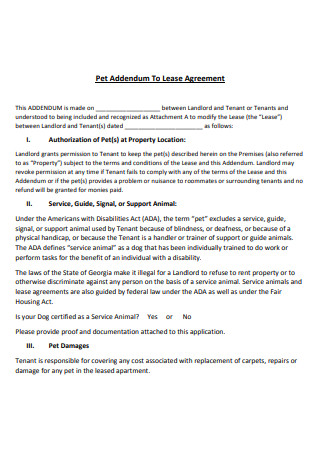
Pet Addendum to a Lease Agreement Template
download now -
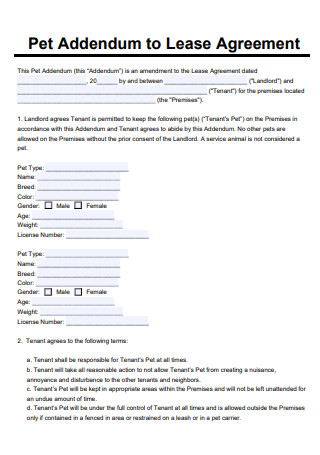
Sample Pet Addendum to a Lease Agreement
download now -

Pet Addendum to a Lease Agreement Example
download now -

Formal Pet Addendum to a Lease Agreement
download now -
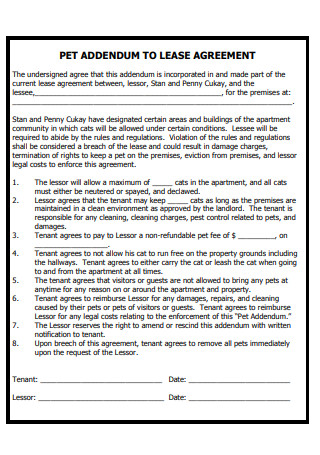
Pet Addendum to a Lease Agreement in PDF
download now -
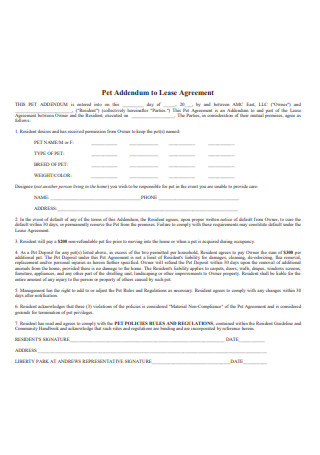
Basic Pet Addendum to a Lease Agreement
download now -
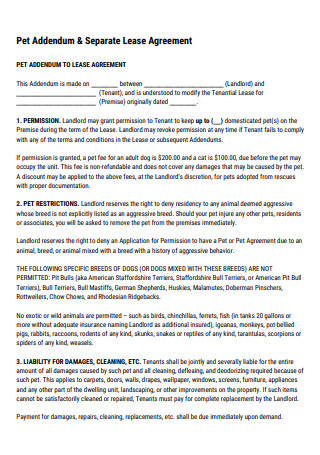
Pet Addendum and Separate Lease Agreement
download now -

Printable Pet Addendum to a Lease Agreement
download now -

Standard Pet Addendum to a Lease Agreement
download now
FREE Pet Addendum to a Lease Agreement s to Download
8+ Sample Pet Addendum to a Lease Agreement
Pet Addendum to a Lease Agreement: What is It?
When Is a Pet Lease Addendum Necessary?
How to write a Pet Addendum to a Lease Agreement?
Additional Landlord Pet Addendum
How to Be a Responsible Pet Owner
FAQs
In a lease agreement, what qualifies as a pet?
What if tenants don’t inform the landlord of a pet?
How will a pet addendum lease benefit a Landlord?
How will a pet addendum form benefit a Tenant?
Pet Addendum to a Lease Agreement: What is It?
A Lease Agreement is an implied or written agreement setting the terms and conditions under which a lessor agrees to rent a property to a lessee.
A Pet Addendum is a clause in a lease agreement that allows a Landlord to establish, disclose, and amend their pet policy. A Pet Addendum will help ensure that all the terms of the pet policy are apparent and carefully documented, whether you’re a Landlord leasing a property or a prospective Tenant with a family pet. The Pet Care Agreement confirms that both parties have come to an understanding of how to handle the presence of pets within the property.
When Is a Pet Lease Addendum Necessary?
When updating an existing Lease Contract or Rental Agreement, people frequently want a change for a pet agreement. Both the Landlord and the Tenant may have consented to a no-pet policy at one time, but both parties have changed their minds in the long run. The pet agreement form is able to document this change and officially state the different rights and responsibilities of having a pet within the premises of the property. To verify that you are allowed to adopt or take an animal home, several animal shelters require a pet addendum or written note from the Landlord.
How to write a Pet Addendum to a Lease Agreement?
Now that the lease pet addendum has been explained to you, it is time to show you the manner and steps in writing the rest of the contents. Again, you don’t have to stress over the format and flow of the document because this article shows you pet addendum examples which you can freely choose which one to use as a foundation for your own pet addendum.
Step 1: State the Basic Information
A basic pet addendum should be able to state the identities of both parties; the names of the Tenant and the Landlord. Along with their contact information and of course, the most important detail being the address of the property that is being discussed or used in the Apartment Lease Contract.
Step 2: Input Pet Information
The second to follow would have to be the number of pets that the Tenant is proposing to move in the property with them. As well as the pet’s given name, the animal type either it would be a canine or a feline, the respective breed of the pet, their age, and gender. Although not necessary, the Tenant can opt to put the details of the Veterinary office of which has the records of their pet. This is to validate that the pet has up-to-date vaccines and is healthy to move in.
Step 3: List out Terms
This step will usually be laid out by the Landlord in clarifying the conditions that the Tenant should follow in order to be permitted to having their pet within the Condominium Rental Agreements that are being leased. Of course, as the Tenant, they are free to share their thoughts about the matter and can suggest compromises if the details are not suitable to their accommodations. Usually, the part where the two parties exchange information to come to an agreement.
Step 4: Additional Pet Fees
Although some Landlords may not require a pet fee or deposit so this step would not be applicable to all. But to those who are planning to require it, the main difference is that the pet fee is a non-refundable application charge for adding a pet to your household while the pet rent is the additional monthly rent charged to a tenant who owns a pet.
There is also a pet security deposit which is a refundable deposit that is refunded to the Tenant if the pet does not cause any damage that is not caused by regular wear and tear or is not covered by a Maintenance Report. Although Landlords are not able to charge pet deposits for Tenants who require a service animal.
Step 5: Signature
As a legally binding document, both parties that have settled and agreed on the details that they have listed above, should sign and acknowledge their agreement. The purpose of a signature is to authenticate a document or convey notice of its source, as well as to obligate the person signing it to the document’s provisions. A Waiver Agreement plays a similar role in signifying both parties are legally involved.
Additional Landlord Pet Addendum
In addition to the basic pet addendum, a Landlord may include the following clauses in the pet addendum in addition to their Rental Lease Agreement:
How to Be a Responsible Pet Owner
No one wants a pet parent to be separated from their pets nor would the pet appreciate that as well. If you are the Tenant, here are tips on how to keep your pet healthy while also keeping your landlord pleased. Remember that as a pet-owning tenant, it is your responsibility to ensure that your pet is a welcome addition to your apartment complex. You may not only have to search for a new apartment if you allow your pet to breach property laws, destroy property, or make others uncomfortable, but you may also risk the chances of other pet owners settling in.
FAQs
In a lease agreement, what qualifies as a pet?
Pets are often defined merely as dogs or cats; some Landlords may not consider additional animals to be permitted. If there are two pets, their combined weight must not surpass a specific limit that the Landlord could establish. Fishbowls may or may not be permitted, but tenants should notify Landlords if they are planning on owning a larger fish tank or an aquarium. Depending on the place of residency, a bird may be considered a household pet but make sure to verify with the Landlord if they permit it.
What if tenants don’t inform the landlord of a pet?
If a renter is discovered bringing a pet into the apartment, the landlord may be able to evict them. The landlord may sue you for the balance of your lease payment if they are evicted. Any prospective landlords who find out about your eviction history may find it difficult to rent to you again.
How will a pet addendum lease benefit a Landlord?
The Landlord wouldn’t have to look for a new renter which can considerably take a lot of time and effort in interviewing them or having them check the recently vacant space. They wouldn’t have to replace any furniture or appliance that has been damaged by the tenant’s untrained pet. Avoid facing a lawsuit from an injured neighbor if the tenant possessed a dangerous breed of pet. And save a lot of effort and money evicting the renter.
How will a pet addendum form benefit a Tenant?
The Tenant wouldn’t have to look for a new rental. They can save up or claim their security deposit if their pet avoids causing harm. Avoid the danger of being sued by a neighbor who has been hurt by an unruly pet. Wouldn’t have to give their pet up for adoption or animal control.
Settling a pet addendum contract is not a tedious thing to do if both parties are seeing eye-to-eye on the agreements that they need to settle. All of the above-stated issues can be avoided if a pet addendum had been included in the contract from the start, thus an Addendum to Contract wouldn’t be such a bad inclusion for the lease agreement. So what are you waiting for? Fuel that excitement because as a tenant, you might be welcoming a new member of the family soon. And as a Landlord, time to prepare those terms and be ready for a new furry companion in the neighborhood.
